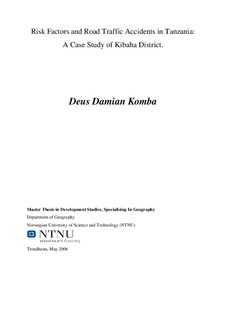| dc.description.abstract | This thesis discusses the risk factors which are associated to the cause of road traffic accidents in Kibaha district in Tanzania; the study describes the composition of motor related injuries including non motorized casualties in Kibaha district. The thesis assesses different road safety measures taken by the local authorities to prevent accidents in Kibaha district.
In identifying risk factor associated to the cause of road traffic accidents, four theoretical frameworks: System theory, risk theory, political ecology and geographical approach have been used as the base of knowledge in this study. The methodology and procedure for data collection employed in the field was based on both qualitative and quantitative approaches within a framework of a case study approach. Interviews with accident victims, government officials, traffic police, focus group discussions with local government authority, observations and review of secondary data at Tumbi hospital of about 855 casualties, were done accordingly.
The study has revealed the pattern and trends of motor traffic accidents in Kibaha district from 2001 to 2004. It shows that the accident occurrence was increasing every year, passengers and pedestrians are always at highest risk of being injured or killed on the road, young males are highly prone to motor traffic accidents. Males are more involved in road accidents than females; the risk of dying in an accident during the night was significantly higher than during the day, especially when it was raining. Driving toward the end of the year in Kibaha district is more risk than others time of the year given a similar level of traffic flow (exposure), Monday, Friday and Saturday are the days when most of the motor vehicle accidents occurred. The study has also described different types of motor related injuries and the survival status of the accident victims. Age, sex, over speeding, reckless driving, being a pedestrian, or a motor cyclist were identified as risk factors to motor vehicle crashes. The distribution of injured and killed casualties residing outside Kibaha district are two times those who reside in Kibaha district, the trend of causalities in Kibaha district stands to be high, there are more casualties in the areas located in small townships with high population density. The study has also identified qualitatively (by interviews) that the technical element of the highway construction, corruption, irresponsibility, poor management, driving while using cell phone, driving without training, failure to respect and obey traffic regulations, bad condition of vehicles, age of the vehicles and poor condition of services as the important risk factors associating to the cause of traffic accidents in Kibaha district
The field work came under some constraints, the time given for the field work was limited and the bureaucratic procedures in the government institutions created some delays. The recording system of road traffic accidents at the police station and Tumbi hospital are manually maintained hence it consumed time in sorting out information and some of the information was missing especially those pertaining to referred cases. To combat these constrains, the study used multiple methods to explore information for a more comprehensive picture of risk factors and road traffic accidents.
In order to reduce traffic accidents in Kibaha district, it is recommended that the government should review legislation regarding employment of drivers; NIT should be given a statutory mandate to train the drivers. Working conditions of police force should be improved, public road safety campaigns should be conducted, and new driving license system should be imposed. The use of cell phones while driving should be restricted. The hospital and police record keeping should be strengthened, the hospital staff, traffic police and ambulance personnel should be considered for intensive training on emergency and preparedness, and regular vehicle inspection should be introduced in the country. | nb_NO |
